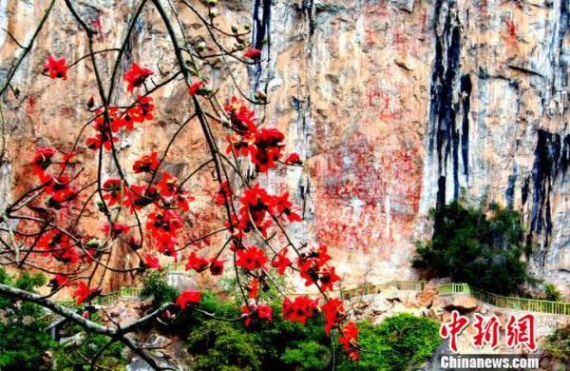
Rock paintings from China's Guangxi Zhuang Autonomous Region has been listed as world heritage by the World Heritage Committee, at its 40th session in Istanbul. (Photo/Chinanews.com)
Etched and drawn on high cliffs and hidden mountains in southwest China, the Jinshajiang River rock paintings are hard to find and even harder to protect.
Discovered in the 1980s by local hunters, the rock paintings, which are believed to date back to the early Neolithic period, are among the most famed rock paintings in China.
Last month, the Zuojiang Huashan rock paintings in southern China's Guangxi Zhuang Autonomous Region were included in the UNESCO's world heritage list, heightening calls for the protection of such paintings.
The Zuojiang Huashan site covers over 6,621 hectares and is home to more than 1,900 well-preserved drawings on the face of the Huashan mountains along the Zuojiang River.
However, global warming, human activity and the construction of engineering projects have been endangering such rock paintings in China, experts said.
Unlike the the Zuojiang Huashan paintings, which are of rice growers and frog-shaped people -- a totem of the Zhuang ethnic group, Jinshajiang's paintings are mainly of wild animals such as cows, deer, sheep, pigs and monkeys. There are just a few human images alongside abstract symbols and graphics.
Researchers believe the paintings reflect the lives, religion, culture and art of nomadic people dating back thousands of years.
So far, a total of 1,900 square meters of Jinshajiang rock painting, with close to 10,000 images in 85 sites, have been recorded. Most of them are found in the Deqen Tibetan prefecture and Lijiang city in Yunnan, as well as Daocheng and Muli counties in Sichuan.
"Rock paintings stay well preserved in dry environments, but global warming has brought more rainfall, which has eroded many paintings. Growth of moss and microbiotic substances also damaged the structure of the rocks," said Li Gang, a researcher with Deqen prefectural relics management institute.
Farmers herding cattle in the wild could also easily damage and destroy paintings, he said.
Building a copper mine, railways, a highway and hydropower stations along the Jinshajiang River also affected the rocks.
"We had to get some of the paintings down for protection before construction work began," said Li.
Chinese rock paintings are found in the northwest Altai and Helan mountains, and in the southern provincial-level regions of Guangxi, Sichuan, Yunnan, Guizhou and Fujian. Though many paintings have already been put under state or local protection, it is still difficult to keep them intact due to their locations.
"Rock paintings in the wild are immovable, and the cost of protecting them is high," said Ma Bo, a researcher with Yunnan provincial relics research institute.
Studying rock painting is a dangerous and challenging task.
"There were no roads in the mountains, so we climbed with our bare hands, sticking our feet into the crevices on the mountain and clinging to small holes on the cliff," said Li.
"The forbidding environment means researchers believe that there may be many more rock paintings yet to be discovered."


















































